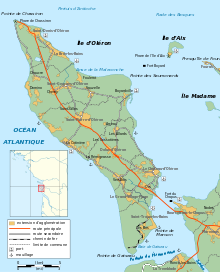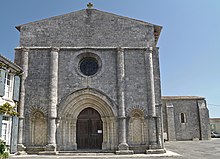 Aerial photograph of Oléron Aerial photograph of Oléron | |
 | |
| Geography | |
|---|---|
| Location | Atlantic Ocean |
| Coordinates | 45°55′30″N 1°16′57″W / 45.92500°N 1.28250°W / 45.92500; -1.28250 |
| Area | 174 km (67 sq mi) |
| Length | 30 km (19 mi) |
| Width | 8 km (5 mi) |
| Highest elevation | 34 m (112 ft) |
| Administration | |
| France | |
| Region | Nouvelle-Aquitaine |
| Department | Charente-Maritime |
| Arrondissement | Rochefort |
| Largest settlement | Saint-Pierre-d'Oléron (pop. 6,687) |
| Demographics | |
| Demonym | Oléronais(e) |
| Population | 21,871 (2010) |
| Pop. density | 126/km (326/sq mi) |
| Ethnic groups | French people |

The Isle of Oléron or Oléron Island (French: île d'Oléron, [il dɔleʁɔ̃]; Saintongese: ilâte d'Olerun; Latin: Uliaros insula, [uliˈaːros ˈinsula]) is an island off the Atlantic coast of France (due west of Rochefort), on the southern side of the Pertuis d'Antioche strait.

It is the second largest island of Metropolitan France, after Corsica, with a length of 30 km (19 mi) and a width of 8 km (5 mi). It has an area of 174 km (67 sq. mi.) and more than 21,000 permanent inhabitants.
History
Oleron has been known since the 1st century, where Pliny the Elder refers to it in his Natural History as Uliaros ("in aquitanico sinu Vliaros").

Towards the end of the 3rd century, the Roman emperor Probus extended the privilege of owning vineyards and producing wine to all Gauls, and this led to a culture of winemaking developing on the island. This lasted until the end of the 19th century, when the arrival of phylloxera decimated almost all the vines. The vineyards did not recover, and grape production today is mainly for Cognac bois ordinaires.
In the 7th and 8th century, the island, along with Ré, formed the Vacetae Insulae or Vacetian Islands, according to the Cosmographia. Vaceti was another name for the Vascones, the reference is seen evidence of Basque (Gascon) control of the islands by that time.
It was at Oléron in about 1152 to 1160 that Eleanor of Aquitaine introduced the first 'maritime' or 'admiralty' laws in that part of the world: the Rolls of Oléron. In 1306, Edward I of England granted the island to his son, Edward II, as part of the Duchy of Aquitaine.
In 1793, during the French Revolution, the villages of the isle of Oléron were renamed. The Château d'Oléron became "Equality", Saint-Trojan became "La Montagne", Dolus became "Sans-Culotte", Saint-Pierre became "La Fraternité" and Saint-Georges became "L'Unité". The overall territory of Oleron became the island of Liberty. A few years later, the original names were given back to the villages and towns.
During the Second World War, the island was occupied by German forces and fortified. It was liberated by Free French Forces in an amphibious assault code-named Operation Jupiter on 29 April 1945. The French cruiser Duquesne fired 550 heavy shells at the German artillery batteries, and the garrison surrendered on the following day.
The isle of Oléron is known today for the quality of its oyster production.
Geography and climate

The island has an area of about 174 km (67 sq mi). It is a fertile and well cultivated island on the Atlantic coast of France, that is on the Bay of Biscay.
The climate is generally mild (maritime temperate) with sufficient but not excessive rainfall, but with probably from 3 to 15 days of intense heat in the summer months of July and August, mostly grouped.
Oleron is located in the heart of the sunniest area of the French Atlantic coast. The island benefits from more than 2100 hours per year.
| Climate data for Île d'Oléron (Chassiron), 1981–2010 normals, extremes 1884–present | |||||||||||||
|---|---|---|---|---|---|---|---|---|---|---|---|---|---|
| Month | Jan | Feb | Mar | Apr | May | Jun | Jul | Aug | Sep | Oct | Nov | Dec | Year |
| Record high °C (°F) | 17.2 (63.0) |
20.4 (68.7) |
23.4 (74.1) |
26.7 (80.1) |
31.2 (88.2) |
35.6 (96.1) |
35.0 (95.0) |
35.9 (96.6) |
32.8 (91.0) |
28.8 (83.8) |
21.2 (70.2) |
18.6 (65.5) |
35.9 (96.6) |
| Mean daily maximum °C (°F) | 9.3 (48.7) |
9.8 (49.6) |
12.3 (54.1) |
14.4 (57.9) |
17.8 (64.0) |
20.7 (69.3) |
22.5 (72.5) |
22.7 (72.9) |
21.0 (69.8) |
17.6 (63.7) |
13.1 (55.6) |
10.1 (50.2) |
16.0 (60.8) |
| Daily mean °C (°F) | 7.3 (45.1) |
7.6 (45.7) |
9.8 (49.6) |
11.7 (53.1) |
15.0 (59.0) |
17.9 (64.2) |
19.8 (67.6) |
20.0 (68.0) |
18.2 (64.8) |
15.1 (59.2) |
10.9 (51.6) |
8.0 (46.4) |
13.5 (56.3) |
| Mean daily minimum °C (°F) | 5.3 (41.5) |
5.3 (41.5) |
7.4 (45.3) |
9.1 (48.4) |
12.3 (54.1) |
15.1 (59.2) |
17.1 (62.8) |
17.3 (63.1) |
15.3 (59.5) |
12.6 (54.7) |
8.7 (47.7) |
5.9 (42.6) |
11.0 (51.8) |
| Record low °C (°F) | −10.0 (14.0) |
−9.2 (15.4) |
−5.2 (22.6) |
−0.8 (30.6) |
4.6 (40.3) |
7.2 (45.0) |
10.2 (50.4) |
10.0 (50.0) |
7.8 (46.0) |
1.0 (33.8) |
−2.0 (28.4) |
−8.8 (16.2) |
−10.0 (14.0) |
| Average precipitation mm (inches) | 68.0 (2.68) |
51.9 (2.04) |
46.9 (1.85) |
58.9 (2.32) |
50.9 (2.00) |
38.7 (1.52) |
41.8 (1.65) |
37.1 (1.46) |
56.8 (2.24) |
80.7 (3.18) |
87.4 (3.44) |
83.7 (3.30) |
702.8 (27.67) |
| Average precipitation days (≥ 1.0 mm) | 11.9 | 9.4 | 9.2 | 10.5 | 9.2 | 6.6 | 6.6 | 5.9 | 7.4 | 11.6 | 12.3 | 12.9 | 113.6 |
| Mean monthly sunshine hours | 78.8 | 112.5 | 155.5 | 205.7 | 238.5 | 252.4 | 282.2 | 264.6 | 195.0 | 131.7 | 94.2 | 68.6 | 2,079.8 |
| Source 1: Meteociel | |||||||||||||
| Source 2: Météo Climat | |||||||||||||
| Climate data for Île d'Oléron (Château-d'Oléron), 1981–2010 normals, extremes 1989–present | |||||||||||||
|---|---|---|---|---|---|---|---|---|---|---|---|---|---|
| Month | Jan | Feb | Mar | Apr | May | Jun | Jul | Aug | Sep | Oct | Nov | Dec | Year |
| Record high °C (°F) | 16.5 (61.7) |
20.3 (68.5) |
23.5 (74.3) |
29.1 (84.4) |
31.0 (87.8) |
36.3 (97.3) |
37.1 (98.8) |
39.0 (102.2) |
34.6 (94.3) |
29.4 (84.9) |
22.7 (72.9) |
19.1 (66.4) |
39.0 (102.2) |
| Mean daily maximum °C (°F) | 9.6 (49.3) |
10.7 (51.3) |
13.5 (56.3) |
15.6 (60.1) |
19.7 (67.5) |
22.6 (72.7) |
24.5 (76.1) |
25.0 (77.0) |
22.2 (72.0) |
18.1 (64.6) |
13.1 (55.6) |
9.8 (49.6) |
17.1 (62.8) |
| Daily mean °C (°F) | 7.1 (44.8) |
7.8 (46.0) |
10.2 (50.4) |
12.2 (54.0) |
16.0 (60.8) |
18.8 (65.8) |
20.6 (69.1) |
21.0 (69.8) |
18.4 (65.1) |
15.0 (59.0) |
10.4 (50.7) |
7.3 (45.1) |
13.8 (56.8) |
| Mean daily minimum °C (°F) | 4.7 (40.5) |
4.9 (40.8) |
6.9 (44.4) |
8.7 (47.7) |
12.3 (54.1) |
15.0 (59.0) |
16.7 (62.1) |
17.0 (62.6) |
14.5 (58.1) |
12.0 (53.6) |
7.8 (46.0) |
4.9 (40.8) |
10.5 (50.9) |
| Record low °C (°F) | −6.6 (20.1) |
−6.5 (20.3) |
−4.6 (23.7) |
0.8 (33.4) |
5.1 (41.2) |
9.6 (49.3) |
10.0 (50.0) |
11.4 (52.5) |
7.7 (45.9) |
1.1 (34.0) |
−3.7 (25.3) |
−7.9 (17.8) |
−7.9 (17.8) |
| Average precipitation mm (inches) | 76.5 (3.01) |
56.6 (2.23) |
55.0 (2.17) |
67.0 (2.64) |
57.1 (2.25) |
42.0 (1.65) |
40.6 (1.60) |
41.0 (1.61) |
64.9 (2.56) |
96.0 (3.78) |
94.6 (3.72) |
93.3 (3.67) |
784.6 (30.89) |
| Average precipitation days (≥ 1 mm) | 12.0 | 9.8 | 10.2 | 10.6 | 9.3 | 7.1 | 6.9 | 6.4 | 7.6 | 12.2 | 12.8 | 13.1 | 118.1 |
| Source: Meteociel | |||||||||||||
Administration
Administratively, the island belongs to the Charente-Maritime département, in the Nouvelle-Aquitaine région. The island is divided into 8 communes:

- La Brée-les-Bains
- Le Château-d'Oléron
- Dolus-d'Oléron
- Le Grand-Village-Plage
- Saint-Denis-d'Oléron
- Saint-Georges-d'Oléron (includes Boyardville)
- Saint-Pierre d'Oléron
- Saint-Trojan-les-Bains
The island has about 22,000 inhabitants.
Transportation

Since 1966, the island has been connected to the mainland by a road bridge. With a length of 2,862 m (9,390 ft) between abutments, it was the longest bridge in France at the time of construction. It is now the third one, after the Saint-Nazaire bridge and the Île de Ré bridge. It has been toll-free since 1991.
To get to the island, it is possible to arrive at the stations of Surgères, Saintes or Rochefort, then take the bus. On the island itself, the easiest way to get around is by car or by bicycle. During the last ten years, a network of 110 kilometers (68 miles) of bicycle paths have been built. These bicycle lanes are mostly car-free.
Tourism

As a large Atlantic island only 3 kilometres (1.9 miles) off the Aquitanian coast of France, Oléron is a popular tourist destination. Several companies operate boat trips from the towns of Boyardville and Saint-Denis to the nearby Île d'Aix, La Rochelle, and past the Fort Boyard. The port towns are frequently visited by tourists, especially the village of La Cotiniere. This village is the base for a hundred trawlers who sell their fish every day at 5 am and 4 pm. La Cotiniere was the first fishing port in the department of Charente-Maritime, and the 8th of France.
Notes
- Henderson, Jeffrey. "Pliny Natural History: Book IV: Chapter XIX". Loeb Classical Library. Archived from the original on 31 May 2023. Retrieved 31 May 2023.
- "Historique". Vignoble de l'île d'Oléron (in French). Archived from the original on 31 May 2023. Retrieved 31 May 2023.
- AlejTech.sk. "Coulon XO Île d'Oléron Très Vieille Réserve". cognacinfo.com (in French). Archived from the original on 5 June 2023. Retrieved 5 June 2023.
- Collins' book, p. 214.
- "Noms des communes de la Charente-Maritime sous la Révolution française — Geneawiki". fr.geneawiki.com. Archived from the original on 1 June 2023. Retrieved 1 June 2023.
- Auphan, Paul; Mordai, Jacques (1959). The French Navy in World War II. Annapolis MD: United States Naval Institute. pp. 353–354. ISBN 978-1-59114-566-0. Archived from the original on 2024-05-30. Retrieved 2021-11-17. (2016 edition)
- "Historique | huîtres Marennes Oléron". www.huitresmarennesoleron.info. Archived from the original on 1 June 2023. Retrieved 1 June 2023.
- http://www.ile-oleron-marennes.com/ Archived 2006-07-05 at the Wayback Machine by La Maison du Tourisme de l'île d'Oléron et du bassin de Marennes 2007
- Paris, Meteo. "Actualités météo: L'ensoleillement en France et son évolution ces dernières années 26/04/2022". www.meteo-paris.com (in French). Archived from the original on 1 June 2023. Retrieved 1 June 2023.
- "Normales et records pour Chassiron (17)". Meteociel. Archived from the original on 19 September 2020. Retrieved 11 September 2020.
- "Île d'Oléron weather extremes". Météo Climat. Archived from the original on 4 October 2020. Retrieved 19 September 2018.
- "Normales et records pour Chateau d'Oleron (17)". Meteociel. Archived from the original on 19 September 2020. Retrieved 11 September 2020.
- fr:Île d'Oléron
Sources
- Collins, Roger. "The Vaccaei, the Vaceti, and the rise of Vasconia." Studia Historica VI. Salamanca, 1988. Reprinted in Roger Collins, Law, Culture and Regionalism in Early Medieval Spain. Variorum, 1992. ISBN 0-86078-308-1.